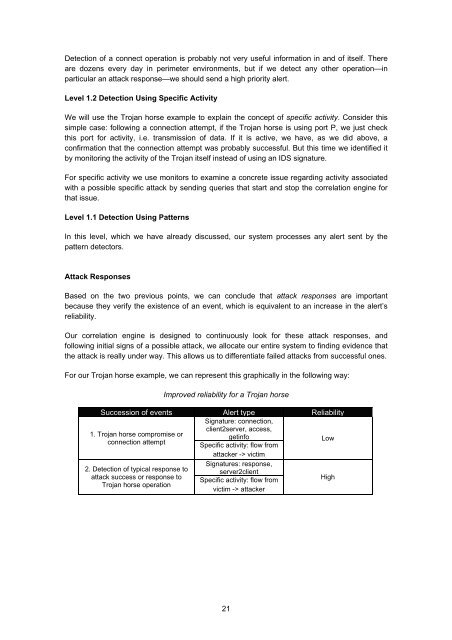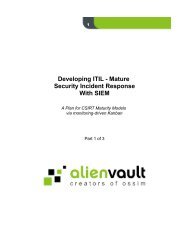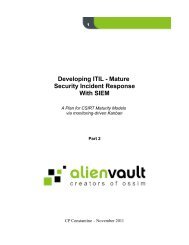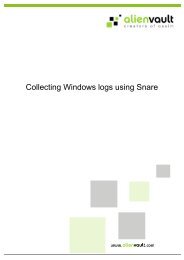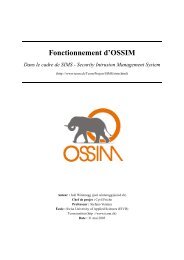ossim - AlienVault
ossim - AlienVault
ossim - AlienVault
Create successful ePaper yourself
Turn your PDF publications into a flip-book with our unique Google optimized e-Paper software.
Detection of a connect operation is probably not very useful information in and of itself. There<br />
are dozens every day in perimeter environments, but if we detect any other operation—in<br />
particular an attack response—we should send a high priority alert.<br />
Level 1.2 Detection Using Specific Activity<br />
We will use the Trojan horse example to explain the concept of specific activity. Consider this<br />
simple case: following a connection attempt, if the Trojan horse is using port P, we just check<br />
this port for activity, i.e. transmission of data. If it is active, we have, as we did above, a<br />
confirmation that the connection attempt was probably successful. But this time we identified it<br />
by monitoring the activity of the Trojan itself instead of using an IDS signature.<br />
For specific activity we use monitors to examine a concrete issue regarding activity associated<br />
with a possible specific attack by sending queries that start and stop the correlation engine for<br />
that issue.<br />
Level 1.1 Detection Using Patterns<br />
In this level, which we have already discussed, our system processes any alert sent by the<br />
pattern detectors.<br />
Attack Responses<br />
Based on the two previous points, we can conclude that attack responses are important<br />
because they verify the existence of an event, which is equivalent to an increase in the alert’s<br />
reliability.<br />
Our correlation engine is designed to continuously look for these attack responses, and<br />
following initial signs of a possible attack, we allocate our entire system to finding evidence that<br />
the attack is really under way. This allows us to differentiate failed attacks from successful ones.<br />
For our Trojan horse example, we can represent this graphically in the following way:<br />
Improved reliability for a Trojan horse<br />
Succession of events Alert type Reliability<br />
Signature: connection,<br />
client2server, access,<br />
1. Trojan horse compromise or<br />
getinfo<br />
connection attempt<br />
Specific activity: flow from<br />
Low<br />
attacker -> victim<br />
2. Detection of typical response to<br />
attack success or response to<br />
Trojan horse operation<br />
Signatures: response,<br />
server2client<br />
Specific activity: flow from<br />
victim -> attacker<br />
High<br />
21


